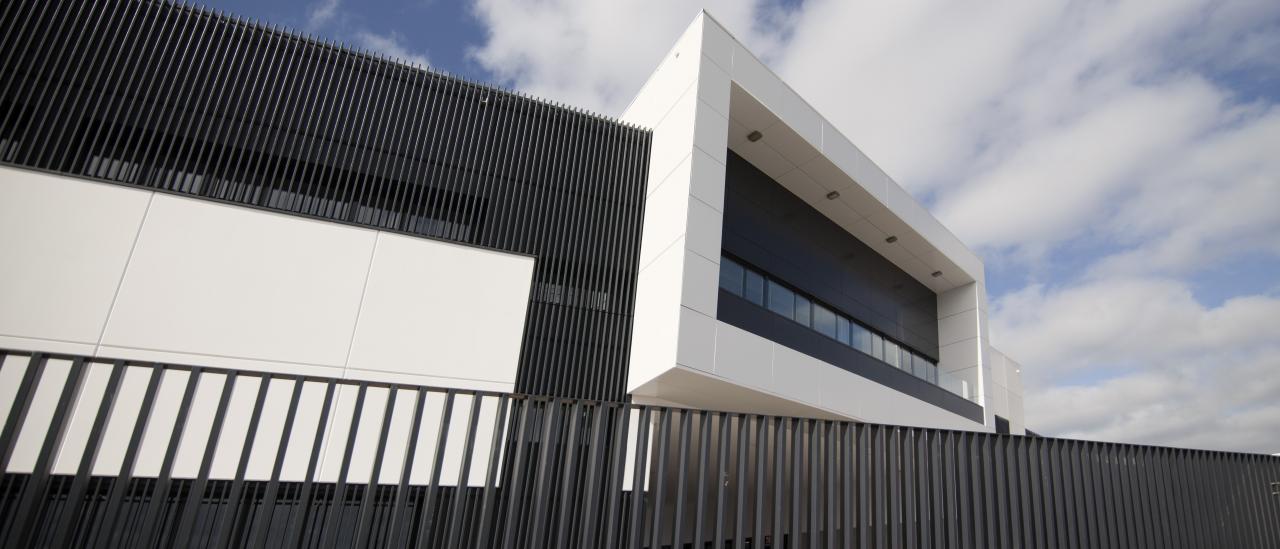Yesterday in La Laguna the new zone of the La Laguna Science and Technology Park La Laguna was inaugurated. The presentation of the buildings of IACTec and Nanotec was attended by Coqui García Román, the manager of INtech Tenerife, who presided at the ceremony; Antonio García Marichal, councillor for the island of Área Tenerife 2030: Innovation, Education, Culture and Sports; Rafael Rebolo López, Director of the IAC; Antonio Martinón Cejas, the Rector of the University of La Laguna; Rosa Dávila Mamely, Head of the Department of Finance of the Canary Government, and Carlos Alonso Rodríguez, President of the Cabildo Insular of Tenerife.
During the inauguration ceremony, Coqui García Román presented the projects that are being undertaken in the installations of the Science and Technology Park “INtech La Laguna”. Antonio García Marichal reminded us that this technological initiative has been a challenge lasting 8 years, which is now becoming a reality. Rafael Rebolo López stressed the firm commitment of the Institute in the transfer of technology to society. Antonio Martinón Cejas explained that the University of La Laguna was contributing more than just the ground to these new installations, and was relying on a knowledge-based economy. During her address, Rosa Dávila Mamely gave an assurance that the “INtech La Laguna” Science and Technology Park will become one of the cornerstones on which the islands of the future will be built. The speaker who closed the proceedings was Carlos Alonso Rodríguez, who thanked everyone for their participation in this project and explained that there were still two buildings to complete in this zone.
Located in the “INtech La Laguna” Science and Technology Park, the new IACTec building, which will be devoted to collaboration by the IAC in technology and business, shares a green space of 30,000 square metres with other buildings serving companies and technology, not far from the IAC headquarters and the university campuses of the city. It has an up to the minute building for companies, of more than 4,000 square metres, with clear rooms, multipurpose laboratories, offices, meeting rooms, store rooms, common spaces, and parking.
From within this new building IACtec will continue to follow its aim of developing, in the Canaries, an innovative “ecosystem” for the transfer of high technology between the public sector and companies, taking advantage of the scientific and technological capital of the IAC. The new installation will provide an accessible environment, rich in human, scientific, technical, and financial resources, where institutions with a vocation for R+D+I can collaborate, developing new partnerships and innovative projects, while they generate a dynamic fabric of production in the Canaries and in Spain, with orientation to Europe.
The IACtec team comprises highly qualified professionals in the fields of engineering and science. It has the technical support of the IAC, in particular from the Instrumentation Division. The IAC is the leader in Spain in the development of advanced instrumentation for astrophysics. It has designed and built, in collaboration with companies in a large number of countries, instruments for the most advanced, complex, and largest telescopes in the world. It is a current participant in the main international projects in the fields of Astrophysics and Space science, and has amassed technical knowledge for over 30 years directed at developing front line instrumentation. The Cabildo Insular of Tenerife, via its “Programme of building capacity in IACtec” (within the programme FT INNOVA 2016-2021), contributes decisively to the training of personnel in engineering and to the IACtec project as a whole.
IACtec is an IAC initiative, with support from public and private entities, such as the Ministry of Science, Innovation, and Universities; the Cabildo Insular of Tenerife; the Science and Technology Park of Tenerife (PCTT); the University of Las Palmas de Gran Canaria (ULPGC); the Canary Agency for Research, Innovation, and the Information Society (ACIISI); and the Spanish Association for Science Industry (INEUSTAR), among others. This branch of the IAC takes as one of its priorities the aim of establishing itself as a centre of reference at national and international levels, for cooperation between the public and private sectors in the field of applied astrophysical instrumentation and related technologies. It also wishes to strengthen the capacities of the IAC reaching the level of technological excellence attained by the Instrumentation Division of the Institute, and complementing its activities in R+D. It also wishes to become a reference node in the Canaries for collaboration between Industry and Science in the production of products and technologies of high benefit, and to be notable as a reference for creating employment by consolidating the fabric of innovative Enterprise in the Canaries.
From its site in the “INtech La Laguna” Science and Technology Park, IACtec will continue to develop its three current lines of activity: its space programme, dedicated to innovation and technological development related to the production of payloads for nano-, micro-, and mini-satellites in the fields of communications, Earth observations, security and environmental management.
The programme of Medical Technology currently focused on the detection and analysis of anomalous thermal patterns using natural radiation in the infrared and microwave ranges, which provides critical data for the diagnostics and handling of illnesses. The other programme is for large telescopes, aimed at the construction of astronomical installations in the Canary Island Observatories. Among its international projects are the Cherenkov Telescope Array (CTA) which, with its more than 100 telescopes divided between two sites, one in the Canaries and one in Chile, will become the largest high energy gamma-ray observatory in the world; the European Solar Telescope (EST), which will be installed in one of the Canary island observatories, and with its 4m diameter mirror will give astrophysicists a unique tool to understand the Sun, and how this determines the weather conditions in space. There is also the New Robotic Telescope (NRT), which will be sited at the Roque de los Muchachos Observatory (Garafía, La Palma) which will also have a mirror of 4m diameter, and which will be the largest, fastest, and most advanced robotic, remote controlled telescope of the world in its class.






